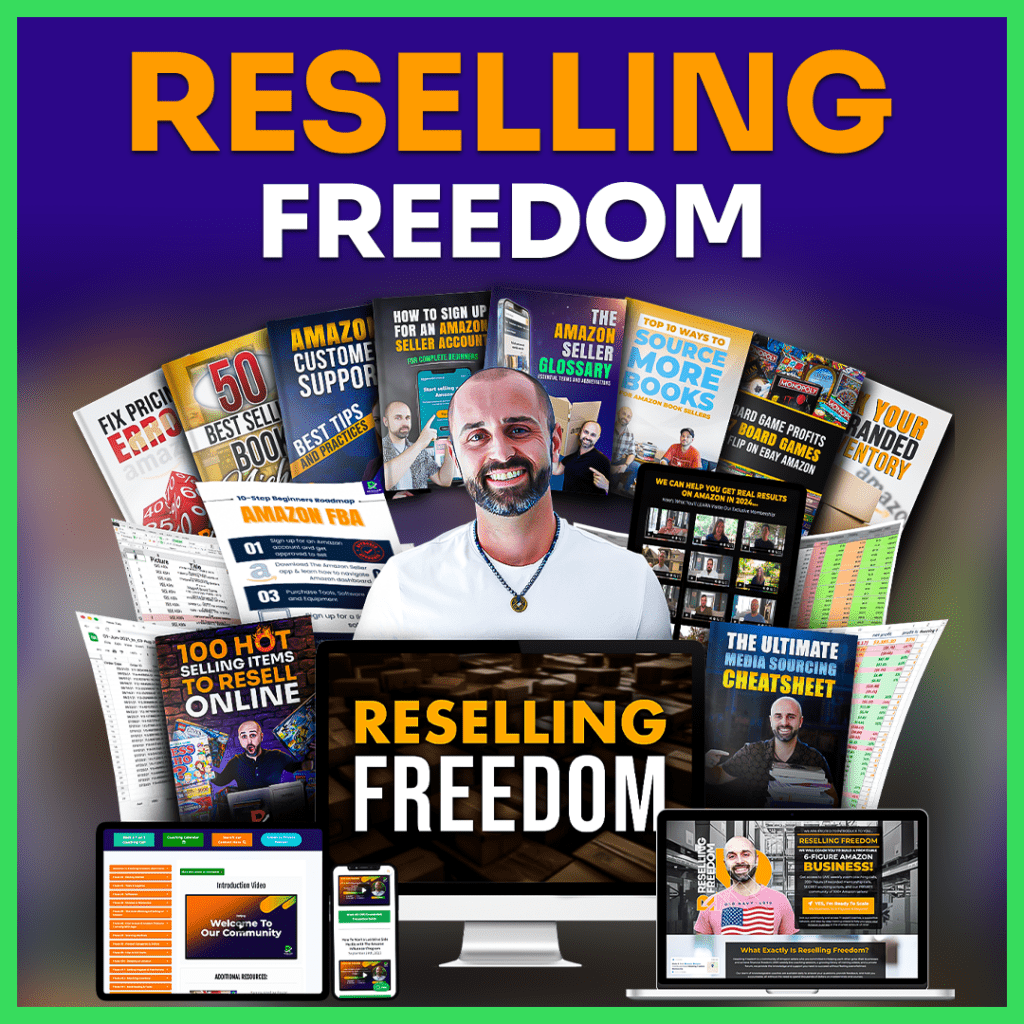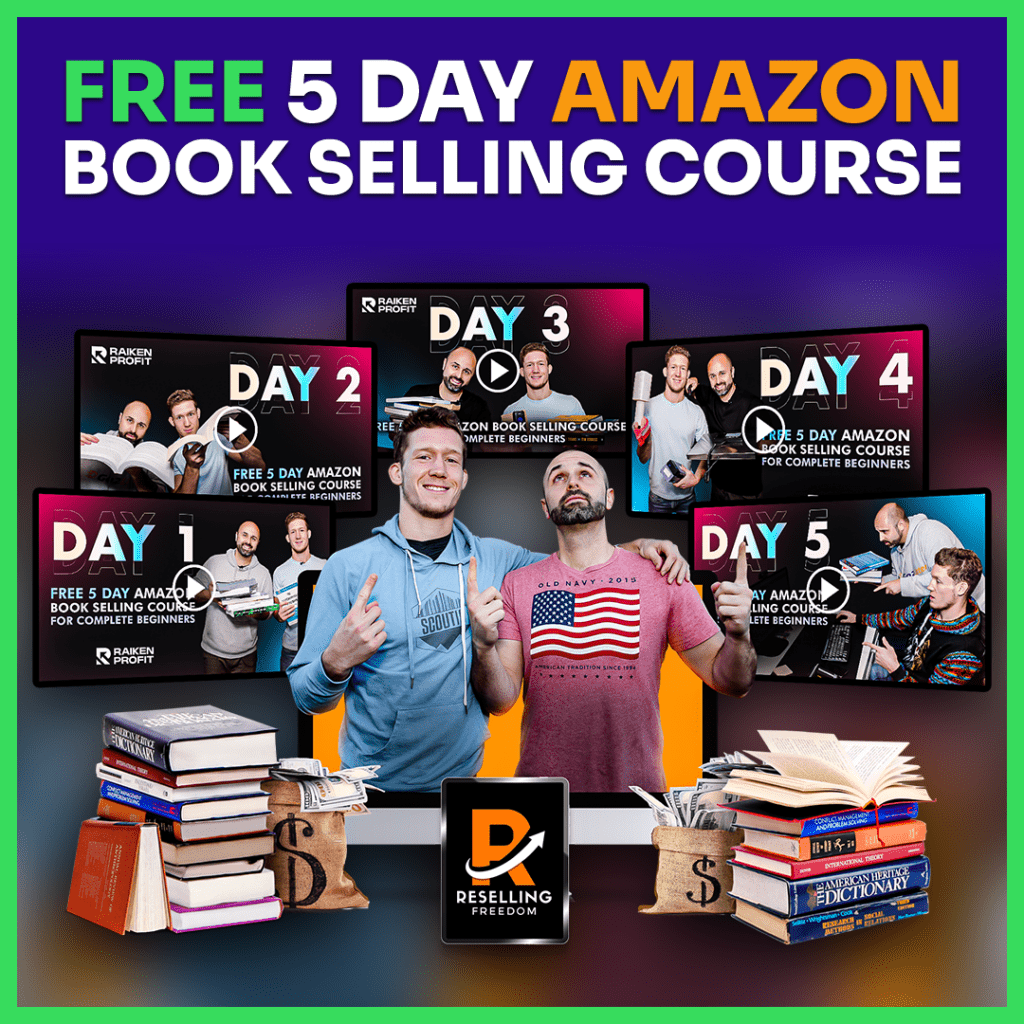
Have you ever considered selling books on Amazon?
Whether you’re thinking about starting an online side hustle or scaling your current book-selling business, the Amazon marketplace has incredible potential—especially for used books and textbooks.
However, 2024 brings new challenges and changes that could make or break your success.
From dealing with counterfeit books to navigating fluctuating prices, selling books on Amazon isn't as simple as it used to be.
In this comprehensive guide, we’ll take you step-by-step through the five essential actions you need to take before purchasing books for resale on Amazon.
If you skip any of these steps, you could end up wasting time, money, or even facing legal consequences.
So, let’s dive in and make sure you’re fully prepared for 2024!
Why Selling Books on Amazon in 2024 Is Different

Before we get into the nitty-gritty details, let’s discuss why the landscape has changed for booksellers.
The marketplace is growing more competitive by the day, counterfeit issues are rising, and Amazon’s policies are getting stricter.
If you want to succeed, you need to adapt to these changes.
- Increased Counterfeit Risks: More counterfeit books, particularly textbooks, are making their way into the marketplace. Selling even one counterfeit book can lead to account suspension or even legal action.
- Shifting Price Trends: Amazon’s algorithms, seller competition, and demand fluctuations are more unpredictable than ever. Understanding price movements and trends is crucial to staying profitable.
- Higher Costs: With Amazon’s rising fees and the increased frequency of returns, small profit margins can quickly turn into losses.
With that said, let’s explore the five steps that will help you navigate these changes and build a profitable book-selling business.
Step 1: Always Use the Book Run Counterfeit Calculator Before You Buy
One of the most important steps you can take in 2024 is ensuring that the books you’re selling are not counterfeit.
While this might seem like a no-brainer, the risks of selling counterfeit textbooks are higher than ever.
If Amazon detects counterfeit items in your inventory, they can suspend or permanently shut down your account.
Worse yet, you could face lawsuits from publishers if you unknowingly sell counterfeit copies of their books.
So, what can you do to protect yourself?
Use the Book Run Counterfeit Calculator
Before buying any book—especially textbooks—run the ISBN through the Book Run Counterfeit Calculator.
This free tool analyzes whether a book is likely to be counterfeit based on data like ISBN and publishing patterns.
Why is this Important?
- Textbooks are high-risk items: While most non-fiction and fiction books are relatively safe, textbooks are prime targets for counterfeiting due to their high resale value. Many counterfeits come from overseas, especially from countries like India, where unauthorized print runs are common.
- Legal consequences: Selling counterfeit textbooks can lead to lawsuits from publishers, and these cases can be incredibly costly, even if you didn’t know the book was fake.
Additional Steps to Take:
- Double-check authenticity with StopCounterfeitTextbooks.com: This site is another valuable resource that will help you identify counterfeit textbooks before you make a costly mistake.
- Inspect physical copies: If you're buying used books in bulk or from thrift stores, inspect the quality closely. Counterfeit textbooks often have slightly off-printing, missing pages, or poor-quality binding.
Here’s a simple table to summarize the counterfeit detection process:
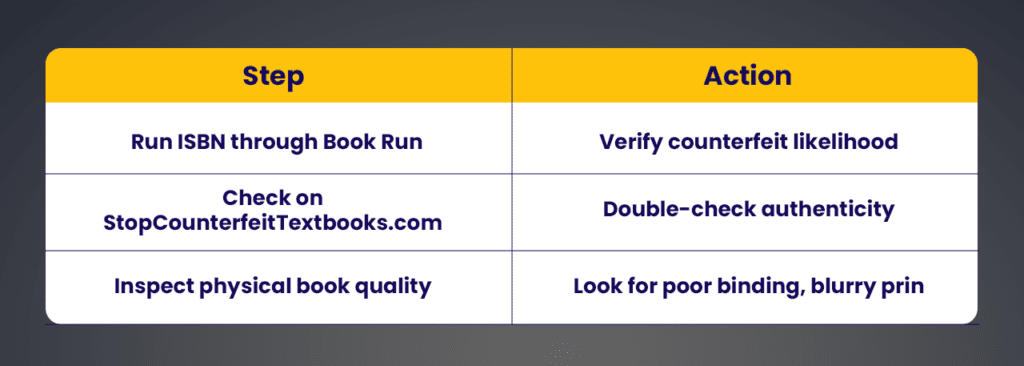
Step 2: Analyze Both Sales Rank and eScore to Ensure the Book Will Sell
It’s easy to get excited about a book with a high potential profit, but the number one mistake sellers make is not considering how often the book will sell.
This is where Sales Rank and eScore come into play.
What Are Sales Rank and eScore?
- Sales Rank: This metric is a snapshot of how well a book is currently selling. The lower the Sales Rank number, the more recent its last sale was.
- eScore: Offered through tools like ScoutIQ, eScore tells you how many times a book has sold over the past six months. This metric gives you a broader view of the book’s sales performance over time.
Why This Matters:
Imagine you find a book with a Sales Rank of 100,000, which seems pretty good. But upon further inspection, you discover that its eScore is only 3.
This means the book has only sold three times in the last six months.
In other words, the book doesn’t sell often enough to justify your investment, and you may end up with slow-moving inventory that ties up your cash.
How to Use This Information:
- When you’re out scanning books with apps like ScoutIQ or Scoutly, always check both the Sales Rank and eScore.
- Short-term vs. Long-term: Sales Rank gives you a short-term snapshot, while eScore provides a long-term view. Both are essential for making informed buying decisions.
Example Scenario:
- Book A: Sales Rank = 150,000, eScore = 40
(This book sells moderately well but consistently over time—great investment!) - Book B: Sales Rank = 75,000, eScore = 3
- (Despite the low Sales Rank, this book only sells occasionally—not worth the risk.)
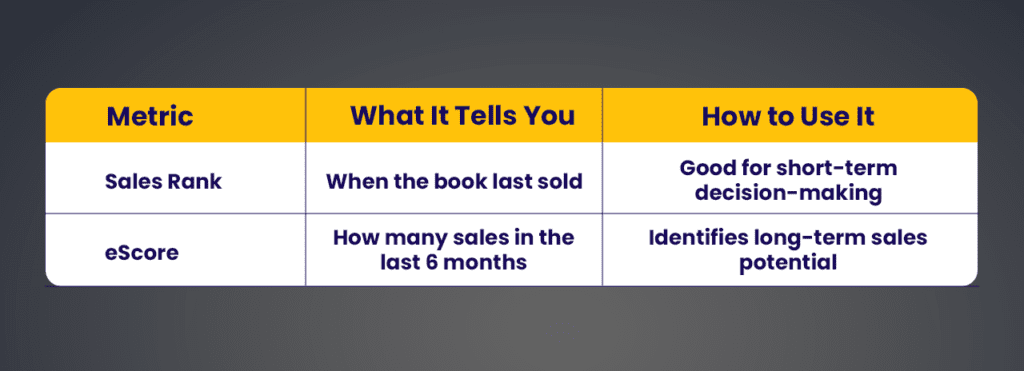
Step 3: Understand Merchant-Fulfilled vs. FBA Price Gaps

Let’s say you’ve scanned a book, and it looks like a goldmine.
The FBA price is $60, but the merchant-fulfilled price is only $30.
This is a common scenario, but it can be deceiving.
As a new seller, it’s important to understand the difference between these two price points and how they can affect your profits.
Why This Matters
Amazon FBA sellers usually list books at higher prices than merchant-fulfilled sellers because of the added convenience of Prime shipping.
However, if the gap between these two prices is too wide, the market might correct itself by driving down the FBA price.
For example:
- You buy a book for $10, thinking you’ll sell it for $60 (FBA price). But within a few weeks, the FBA price drops closer to the $30 merchant-fulfilled price. Now, you’re competing with lower-priced sellers, and your potential profit vanishes.
What Should I Do?
Monitor the competition: If the number of FBA sellers is increasing rapidly, there's a strong chance the price will drop. Keepa also shows seller counts, which is a useful metric to watch.
Check the price history using tools like Keepa.
Keepa allows you to see how the price has fluctuated over time, which helps you avoid listings where prices are trending downward.
Step 4: Monitor the Number of Sellers on a Listing
Another crucial factor in 2024 is keeping an eye on how many sellers are competing on the same book listing.
The more sellers that jump on a listing, the more likely it is that prices will drop due to increased competition.
Why This Matters
- More sellers, lower prices: When the number of sellers on a listing increases, the price generally drops due to oversupply. Too much competition can create a "race to the bottom," where sellers continuously lower their prices in order to win the Buy Box.
- Fewer sellers, higher prices: Conversely, if you notice the number of sellers decreasing and the book's demand remains strong, the price is likely to increase due to scarcity.
How to Monitor Seller Counts:
- Use tools like Keepa or ScoutIQ to track seller trends. Both apps provide real-time insights into how many sellers are on a listing and how that number is changing over time.
- Look for steady listings: Focus on listings where the number of sellers has remained stable or is decreasing, as this typically signals a stronger, more reliable market.
Example:
- Book A: 3 sellers, price stable at $50 (Fewer sellers, consistent demand—good investment)
- Book B: 15 sellers, price dropping from $40 to $25 (Too many sellers driving the price down—avoid)
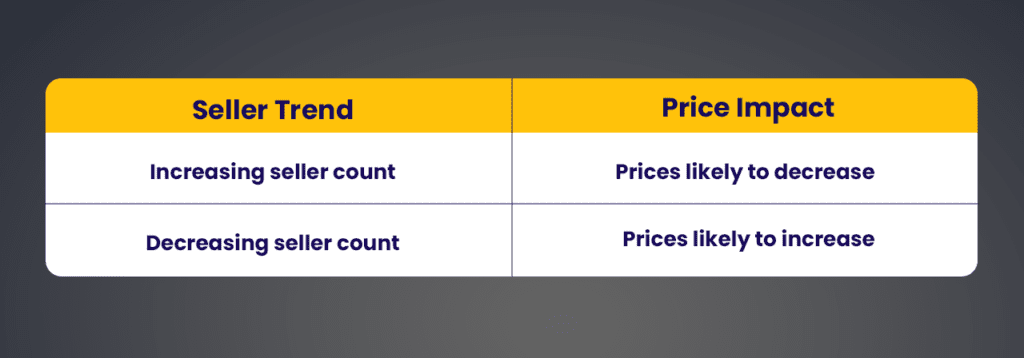
Step 5: Ensure There’s Enough Profit Margin to Make It Worth Your Time
Finally, and perhaps most importantly, you need to make sure there’s enough profit margin on the books you buy.
One of the biggest mistakes new sellers make is going after books that offer only $1-2 in profit.
While that might seem okay in the short term, there are hidden costs that can quickly eat away at those slim margins.
Why Profit Margin Matters:
In 2024, Amazon fees, return costs, and shipping expenses have all gone up. If you’re only making a small profit per book, one return could turn that profit into a loss.
Minimum Profit Rule:
- Aim for a minimum profit margin of $6-7 per book. This will give you some cushion for returns, price drops, and unexpected costs.
- More advanced sellers, like Mike from Reselling Freedom, now aim for a minimum of $8-10 per book to ensure their business remains profitable.
Costs to Consider:
- Amazon fees: These can range from $3-5 per book, depending on the sale price.
- Return costs: When customers return a book, you’re responsible for covering the return shipping, which can cost you $3-4 per book.
- Shipping and handling: If you're shipping books to Amazon FBA, you’ll also need to factor in packaging, labels, and shipping costs, which add another $1-2 per book.
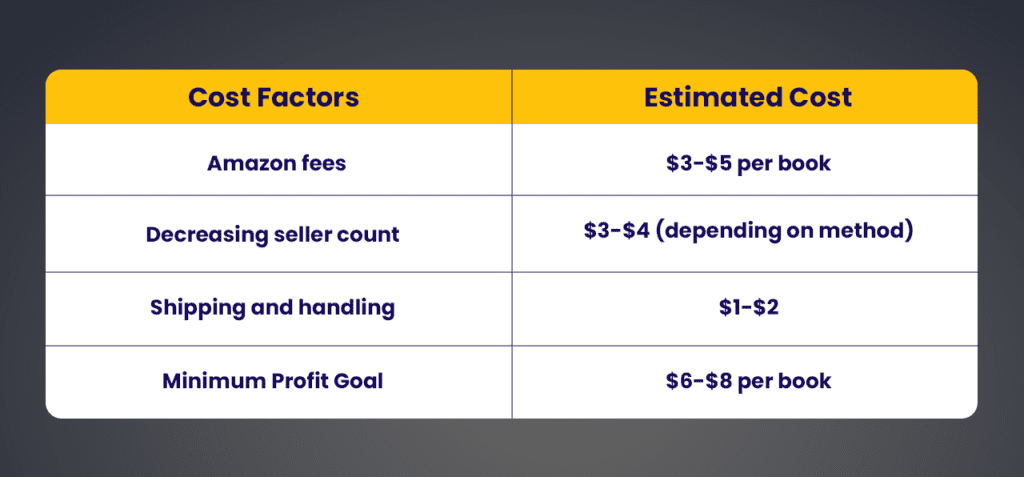
By ensuring a healthy profit margin, you’ll protect yourself from the inevitable ups and downs that come with selling on Amazon.
Conclusion: Building a Profitable Amazon Book Business in 2024
Selling books on Amazon can be a highly lucrative venture if you know what you’re doing.
However, with the changes in the market in 2024, it’s more important than ever to be strategic and cautious.
By following these five essential steps, you’ll not only avoid costly mistakes but also set yourself up for long-term success:
- Use the Book Run Counterfeit Calculator to avoid counterfeit books and protect your account.
- Analyze both Sales Rank and eScore to ensure the books you buy will actually sell.
- Understand the FBA to Merchant-Fulfilled price gap to avoid price tanking.
- Monitor the number of sellers on a listing to predict future price movements.
- Ensure there’s enough profit margin to make the investment worth your time.
Follow these steps, keep learning, and stay flexible.
The book market may be changing, but with the right knowledge and tools, you can build a thriving Amazon book-selling business in 2024 and beyond.
Happy selling!
Steve/w Raiken Profit


